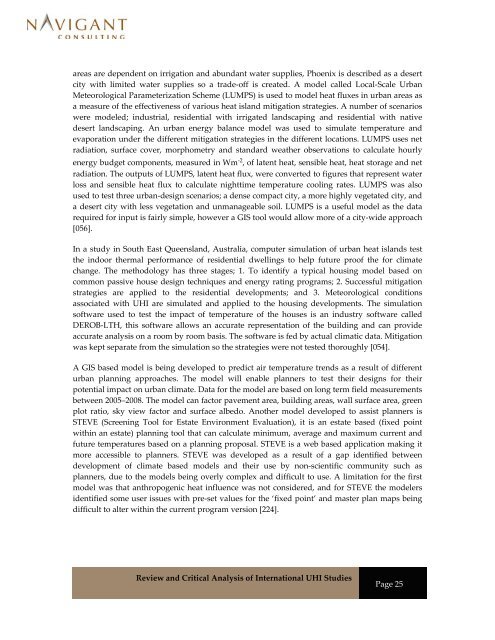Review and Critical Analysis of International UHI Studies
Review and Critical Analysis of International UHI Studies
Review and Critical Analysis of International UHI Studies
Create successful ePaper yourself
Turn your PDF publications into a flip-book with our unique Google optimized e-Paper software.
areas are dependent on irrigation <strong>and</strong> abundant water supplies, Phoenix is described as a desert<br />
city with limited water supplies so a trade‐<strong>of</strong>f is created. A model called Local‐Scale Urban<br />
Meteorological Parameterization Scheme (LUMPS) is used to model heat fluxes in urban areas as<br />
a measure <strong>of</strong> the effectiveness <strong>of</strong> various heat isl<strong>and</strong> mitigation strategies. A number <strong>of</strong> scenarios<br />
were modeled; industrial, residential with irrigated l<strong>and</strong>scaping <strong>and</strong> residential with native<br />
desert l<strong>and</strong>scaping. An urban energy balance model was used to simulate temperature <strong>and</strong><br />
evaporation under the different mitigation strategies in the different locations. LUMPS uses net<br />
radiation, surface cover, morphometry <strong>and</strong> st<strong>and</strong>ard weather observations to calculate hourly<br />
energy budget components, measured in Wm ‐2 , <strong>of</strong> latent heat, sensible heat, heat storage <strong>and</strong> net<br />
radiation. The outputs <strong>of</strong> LUMPS, latent heat flux, were converted to figures that represent water<br />
loss <strong>and</strong> sensible heat flux to calculate nighttime temperature cooling rates. LUMPS was also<br />
used to test three urban‐design scenarios; a dense compact city, a more highly vegetated city, <strong>and</strong><br />
a desert city with less vegetation <strong>and</strong> unmanageable soil. LUMPS is a useful model as the data<br />
required for input is fairly simple, however a GIS tool would allow more <strong>of</strong> a city‐wide approach<br />
[056].<br />
In a study in South East Queensl<strong>and</strong>, Australia, computer simulation <strong>of</strong> urban heat isl<strong>and</strong>s test<br />
the indoor thermal performance <strong>of</strong> residential dwellings to help future pro<strong>of</strong> the for climate<br />
change. The methodology has three stages; 1. To identify a typical housing model based on<br />
common passive house design techniques <strong>and</strong> energy rating programs; 2. Successful mitigation<br />
strategies are applied to the residential developments; <strong>and</strong> 3. Meteorological conditions<br />
associated with <strong>UHI</strong> are simulated <strong>and</strong> applied to the housing developments. The simulation<br />
s<strong>of</strong>tware used to test the impact <strong>of</strong> temperature <strong>of</strong> the houses is an industry s<strong>of</strong>tware called<br />
DEROB‐LTH, this s<strong>of</strong>tware allows an accurate representation <strong>of</strong> the building <strong>and</strong> can provide<br />
accurate analysis on a room by room basis. The s<strong>of</strong>tware is fed by actual climatic data. Mitigation<br />
was kept separate from the simulation so the strategies were not tested thoroughly [054].<br />
A GIS based model is being developed to predict air temperature trends as a result <strong>of</strong> different<br />
urban planning approaches. The model will enable planners to test their designs for their<br />
potential impact on urban climate. Data for the model are based on long term field measurements<br />
between 2005–2008. The model can factor pavement area, building areas, wall surface area, green<br />
plot ratio, sky view factor <strong>and</strong> surface albedo. Another model developed to assist planners is<br />
STEVE (Screening Tool for Estate Environment Evaluation), it is an estate based (fixed point<br />
within an estate) planning tool that can calculate minimum, average <strong>and</strong> maximum current <strong>and</strong><br />
future temperatures based on a planning proposal. STEVE is a web based application making it<br />
more accessible to planners. STEVE was developed as a result <strong>of</strong> a gap identified between<br />
development <strong>of</strong> climate based models <strong>and</strong> their use by non‐scientific community such as<br />
planners, due to the models being overly complex <strong>and</strong> difficult to use. A limitation for the first<br />
model was that anthropogenic heat influence was not considered, <strong>and</strong> for STEVE the modelers<br />
identified some user issues with pre‐set values for the ‘fixed point’ <strong>and</strong> master plan maps being<br />
difficult to alter within the current program version [224].<br />
<strong>Review</strong> <strong>and</strong> <strong>Critical</strong> <strong>Analysis</strong> <strong>of</strong> <strong>International</strong> <strong>UHI</strong> <strong>Studies</strong><br />
Page 25


